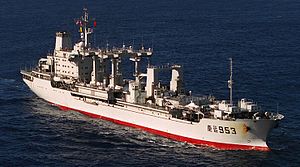HTMS Similan
 |
|
| Class overview | |
|---|---|
| Builders: | Kherson Shipyard, refitted at Dalian Shipyard |
| Operators: | |
| Preceded by: | Type 905 |
| Succeeded by: | Type 903 |
| In commission: | 1996-Present |
| Completed: | 2 |
| Active: | 2 |
| General characteristics | |
| Type: | Replenishment ship |
| Displacement: | 37,000 tonnes |
| Length: | 188.9 m (619.8 ft) |
| Beam: | 25.33 m (83.1 ft) |
| Draught: | 10.41 m (34.2 ft) |
| Propulsion: |
|
| Speed: | 16 knots (30 km/h; 18 mph) |
| Complement: | 125 |
| Aircraft carried: | 1 Z-8 helicopter |
| Aviation facilities: | Hangar and flight deck |
The Type 908 (NATO reporting name Fusu-class, also known as Nancang-class) replenishment ship is a class of multi-product replenishment oilers commissioned into the People's Liberation Army Navy and the Royal Thai Navy. The first Type 908 replenishment ship, Qinghaihu, was originally laid down for the Soviet Navy as a Komandarn Fedko-class merchant tanker, but construction was halted due to insufficient funds. The ship was then purchased by China as an incomplete vessel in 1993 from post-Soviet Ukraine. The ship has a near sister ship (INS Jyoti) operating with the Indian Navy. After significant refit, the ship was consecutively renamed Qinghaihu (885), formerly ex Nancang (Nanyun 953) and ex-Vladimir Peregudov. Another similar ship was built and sold to Thailand and currently in service with the Royal Thai Navy as HTMS Similan (871).
The Type 908 AOR is the second generation Chinese replenishment ship that is outfitted with a total of six cranes, four oil refuelling stations, and two stores stations. This allows the ship to replenish three warships simultaneously. The ship, through her helicopter facilities, is able to replenish warships operating nearby via vertical replenishment (VERTREP).
The Type 908 class was the second stage in Chinese replenishment ship development and construction. Although considered somewhat successful, the first Fuqing class of replenishment oilers could not completely satisfy the requirements of the People's Liberation Army Navy (PLAN). One of the primary drawbacks of this class was that they are mainly for replenishment of liquid supplies, i.e. fuel and water. These ships of the first stage of the development of Chinese replenishment ships could only replenish extremely limited dry supplies, and are virtually incapable of resupply of ammunition, because the Chinese industry at the time lacked the capability to provide sounding safety measures for resupplying and storing ammunition with fuels. This is one of the two primary constrains that despite the fact that on August 28, 1977, the Central Military Commission (People's Republic of China) ordered the resumption of the development of fleet replenishment ship that is capable of one-stop replenishment, (i.e. being capable of resupply ammunition, fuels, water, and solid supplies together by a single ship, a concept first pioneered by United States Navy), the project was eventually put on hold.
...
Wikipedia
